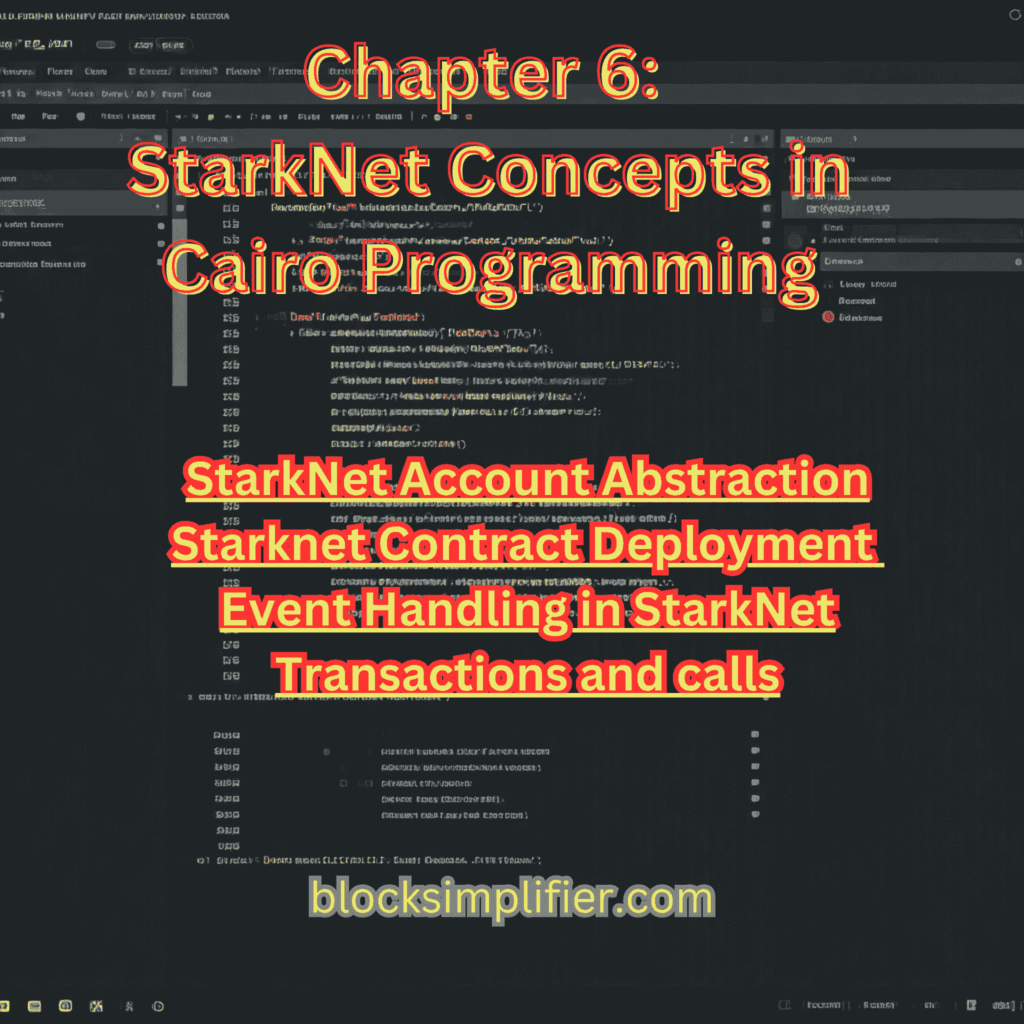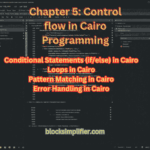StarkNet Account Abstraction: A Deeper Dive
StarkNet Account Abstraction is a modern idea in blockchain technology that transforms how users engage with their debts. Instead of conventional Externally Owned Accounts (EOAs) managed completely by way of private keys, account abstraction empowers users with programmable bills that may be custom designed to suit their unique desires.
StarkNet takes this idea to an entire new level through implementing native account abstraction. This manner that every account on StarkNet is inherently a clever settlement, imparting a huge range of possibilities for better security, usability, and capability.
Table of Contents
Key Advantages of StarkNet Account Abstraction:
- Enhanced Security:
- Social recovery: Implement mechanisms for recovering funds in case of lost or compromised private keys.
- Multi-signature wallets: Distribute manipulate among more than one parties for more suitable security.
- Spending limits: Set limits on transaction quantities to save you unintended or malicious spending.
- Gasless transactions: Paymasters can cover gas fees on behalf of users, making transactions more accessible.
- Improved User Experience:
- Simplified account management: Reduce the weight of coping with private keys and seed terms.
- Customizable functions: Tailor bills to specific use cases, together with computerized payments or delegated management.
- Seamless integration: Integrate with other programs and services for a greater cohesive person experience.
- Advanced Functionality:
- Meta-transactions: Execute transactions without requiring explicit user signatures.
- Conditional transactions: Define complex conditions for executing transactions.
- Delegated management: Grant permission to trusted parties to manage certain aspects of your account.
How Does It Work?
- Account Creation: When you create an account on StarkNet, you set up a smart agreement that defines the logic to your account.
- Transaction Execution: To provoke a transaction, you engage together with your account settlement, presenting the vital records.
- Contract Logic: The account contract validates the transaction based on its programmed logic and executes the transaction if valid.
Visual Representation:
The Future of Account Abstraction
StarkNet’s native account abstraction paves the way for a extra user-friendly and steady blockchain atmosphere. As builders maintain to innovate, we can anticipate to see even greater advanced features and programs constructed upon this effective basis
Transactions and calls
Transactions
- State-changing operations: Transactions are the core mechanism for interacting with and modifying the StarkNet blockchain. They initiate actions that alter the state of the network.
- Key Types:
- Contract Invocation: Calling functions within a deployed contract.
- Contract Deployment: Creating a new instance of a contract on the StarkNet network.
- Fund Transfers: Moving funds (e.g., tokens) between accounts.
- Requirements:
- Signatures: Transactions typically require digital signatures from the account owner to authorize the operation.
- Gas Fees: Users generally pay a fee (gas) to incentivize network participants to process their transactions.
Calls
- Read-only operations: Calls are used to query information from contracts without modifying the blockchain state. They are essentially requests for data.
- Primary Purpose:
- Retrieving data: Obtain information stored within a contract, such as balances, contract states, or function outputs.
- Information gathering: Collect data for decision-making, such as checking contract balances before initiating a transaction.
- No State Changes: Calls do not alter the blockchain’s state or consume any gas.
Key Differences
| Feature | Transactions | Calls |
|---|---|---|
| State Change | Modifies blockchain state | Does not modify blockchain state |
| Signatures | Typically require signatures | Do not require signatures |
| Gas Consumption | Consume gas | Do not consume gas |
| Purpose | Initiate actions, modify state | Retrieve information, query data |
Example
- Transaction: Transferring 10 tokens from your account to another account. This modifies the balance of both accounts.
- Call: Checking the current balance of a specific token in your account. This retrieves information without altering any balances.
In Summary
Transactions are the actions that drive the StarkNet network, as calls are used to negotiate with contracts and store information at no cost or change in the state of the blockchain The difference between these two approaches understanding is critical to effectively interacting with the StarkNet ecosystem.
Starknet Contract Deployment
- Process:
- Write the Contract: Develop the contract logic in the Cairo programming language.
- Compile the Contract: Compile the Cairo code into a format that the StarkNet network can understand (class hash).
- Submit a Transaction: Send a transaction to the StarkNet network containing:
- The compiled code (class hash)
- Constructor arguments (if applicable)
- Network Execution: The StarkNet network verifies and executes the transaction, creating a new contract instance on the blockchain.
- Key Considerations:
- Gas Costs: Deployment transactions consume gas, so it’s essential to optimize contract code to minimize costs.
- Security Audits: Thoroughly audit the contract code for vulnerabilities before deployment to prevent potential exploits.
Address Management
- Deterministic Addresses: StarkNet utilizes a deterministic algorithm to generate contract addresses.
- Key Factors:
- Deployer’s Address: The address of the account deploying the contract.
- Salt: A random value that can be used to create unique addresses for the same contract code.
- Class Hash: The unique identifier of the compiled contract code.
- Benefits:
- Predictability: Contract addresses can be calculated in advance, enabling planning and integration.
- Non-repudiation: The deployer’s address is inherently linked to the deployed contract.
- Address Reuse: Deploying the same contract with different salts allows for multiple instances with unique addresses.
Example
Imagine you’re deploying an ERC20 token contract. The contract’s address would be calculated based on:
- Your account address
- The chosen salt value
- The class hash of the compiled ERC20 token contract
In Summary
Contract deployment and address management are fundamental aspects of the StarkNet ecosystem. Understanding these concepts is crucial for developers to effectively create and interact with decentralized applications on the platform.
Event Handling in StarkNet
- Purpose: Events are a crucial mechanism for StarkNet contracts to communicate information to the outside world. They allow contracts to emit specific data during their execution, which can then be used by external systems or applications.
- Key Characteristics:
- Information Emission: When a specific event occurs within a contract, the contract emits an event containing relevant data.
- Indexing: Events can be indexed, making it efficient to filter and query for specific events based on their data.
How to Work with Events in StarkNet
- Defining Events:
- Use the
#[derive(Drop, starknet::Event)]attribute to define an event.Specify the fields of the event and their respective data types.
#[derive(Drop, starknet::Event)] struct Transfer { from: ContractAddress, to: ContractAddress, amount: felt, } - Use the
- Emitting Events:
- Call the
emit()function associated with the event to trigger its emission.
fn transfer(from: ContractAddress, to: ContractAddress, amount: felt) { // ... logic for transferring funds ... Transfer { from, to, amount }.emit(); } - Call the
- Listening for Events:
- Utilize StarkNet’s event filtering mechanisms to listen for specific events. This can be done through:
- StarkScan: A blockchain explorer that provides tools for filtering and querying events.
- Third-party libraries: Libraries that offer APIs for interacting with the StarkNet network and subscribing to events.
- Utilize StarkNet’s event filtering mechanisms to listen for specific events. This can be done through:
Example Use Case
Consider a decentralized exchange (DEX) contract. When a trade occurs, the contract can emit a TradeExecuted event containing information such as:
- The token pair traded
- The amount of tokens exchanged
- The addresses of the buyer and seller
This information can then be used by:
- Front-end applications to display real-time trade data to users.
- Data analytics platforms to track trading volume and market trends.
- Arbitrage bots to identify and capitalize on price discrepancies.
Key Benefits of Event Handling
- Transparency: Provides a transparent and auditable record of on-chain events.
- Decentralized Communication: Enables communication between contracts and external systems without relying on centralized intermediaries.
- Efficient Data Retrieval: Indexed events allow for efficient filtering and querying of event data.
By effectively utilizing event handling, developers can build more robust, informative, and interactive applications on the StarkNet platform.
- FAQ:
- Defining events in Cairo:
- Use the
#[derive(Drop, starknet::Event)]attribute. - Specify event fields and their data types.
- Use the
- Emitting events:
- Call the
emit()function associated with the event.
- Call the
- Listening for events:
- Utilize StarkNet’s event filtering mechanisms (e.g., StarkScan, third-party libraries).
- Defining events in Cairo:
Additional Notes:
- Cairo: StarkNet’s native programming language, optimized for efficient STARK-friendly computations.
- StarkWare: The company behind StarkNet, is an advanced scaling solution for blockchain.
- L2 Scaling: StarkNet is a Layer 2 scaling solution built on Ethereum, providing fast and inexpensive connections.




Pingback: Chapter 5: Control flow in Cairo Programming - BlockSimplifier
Pingback: Chapter 7: Writing Starknet Smart Contracts in Cairo - BlockSimplifier